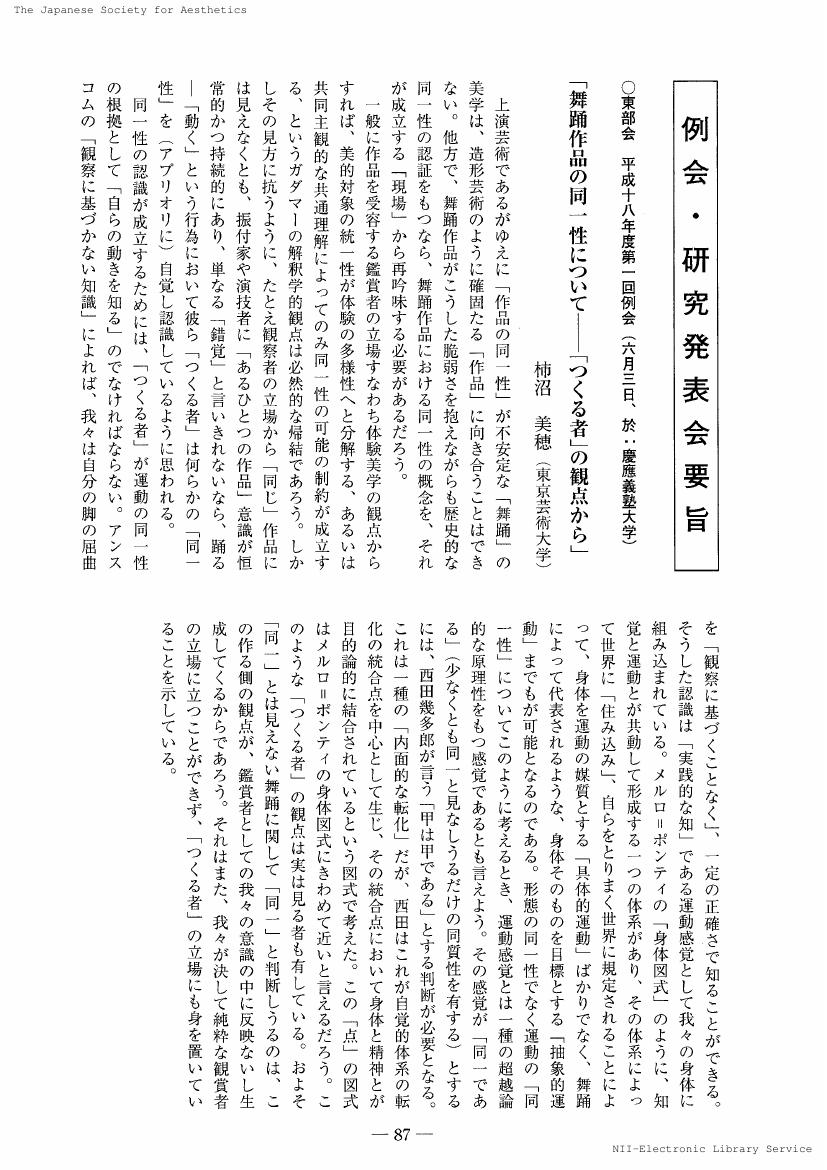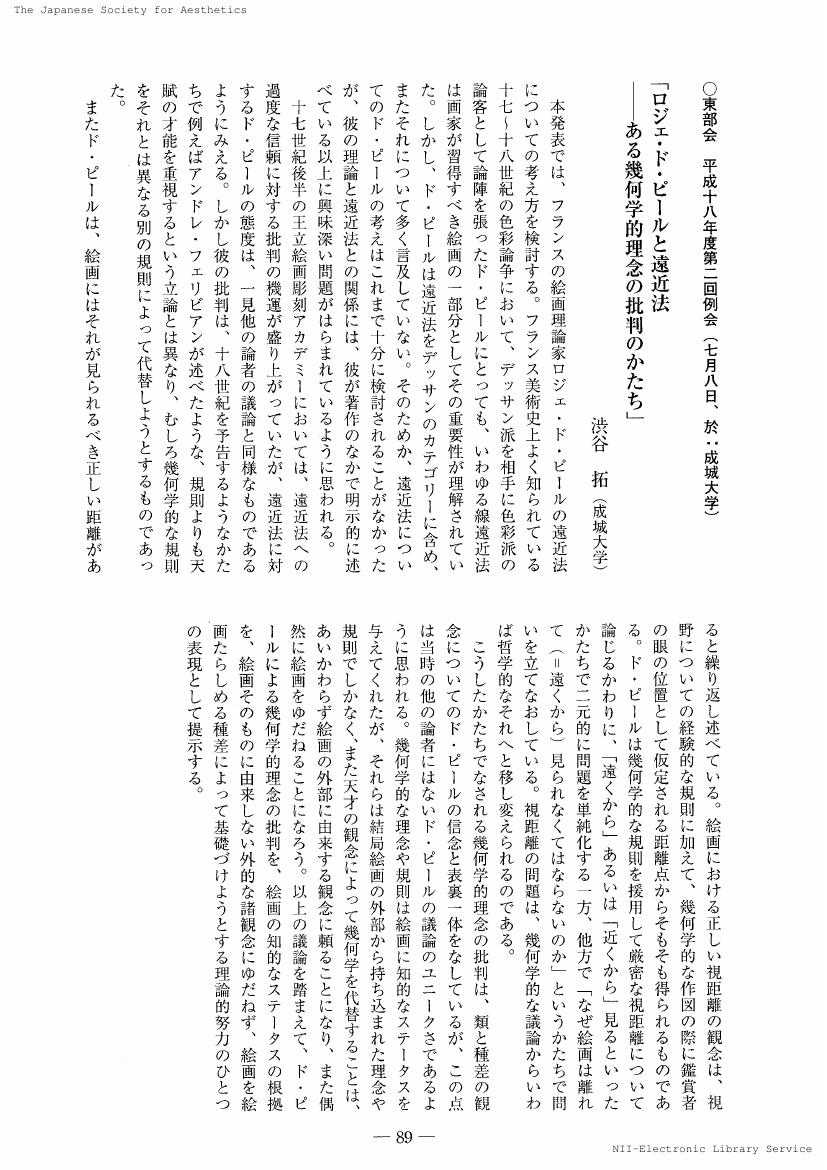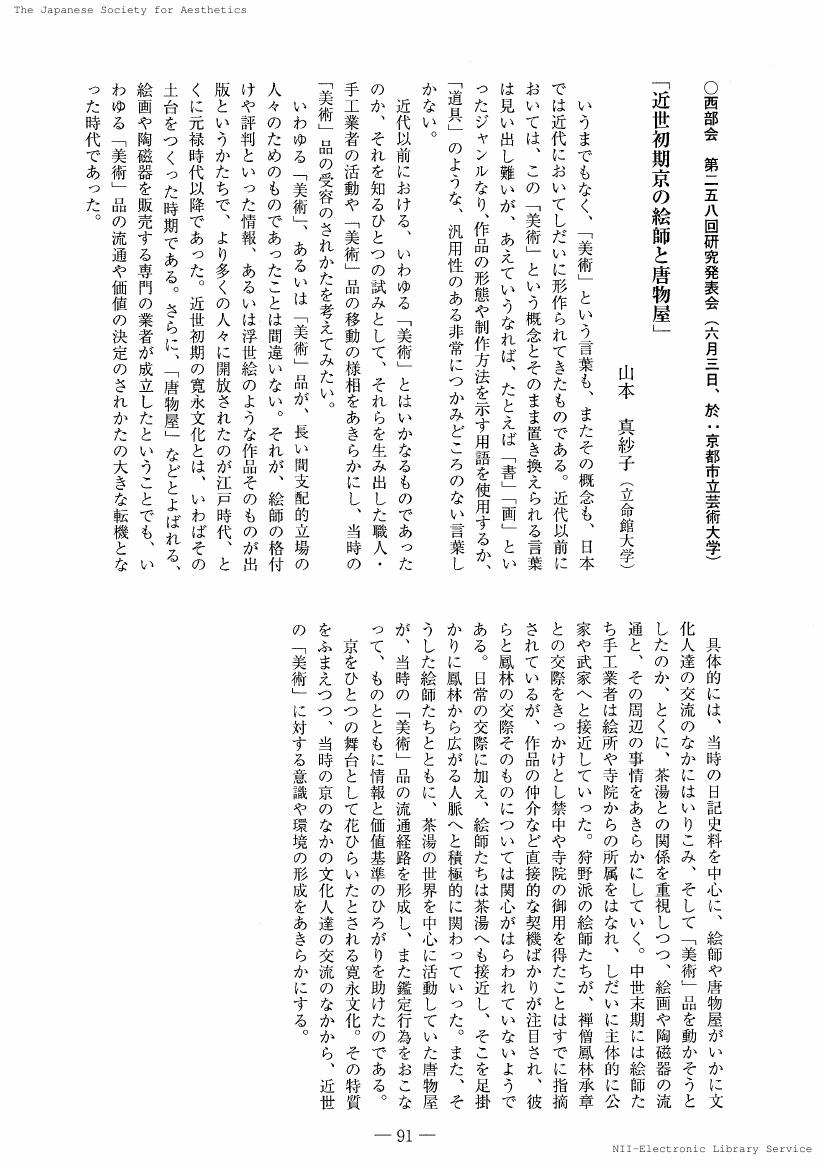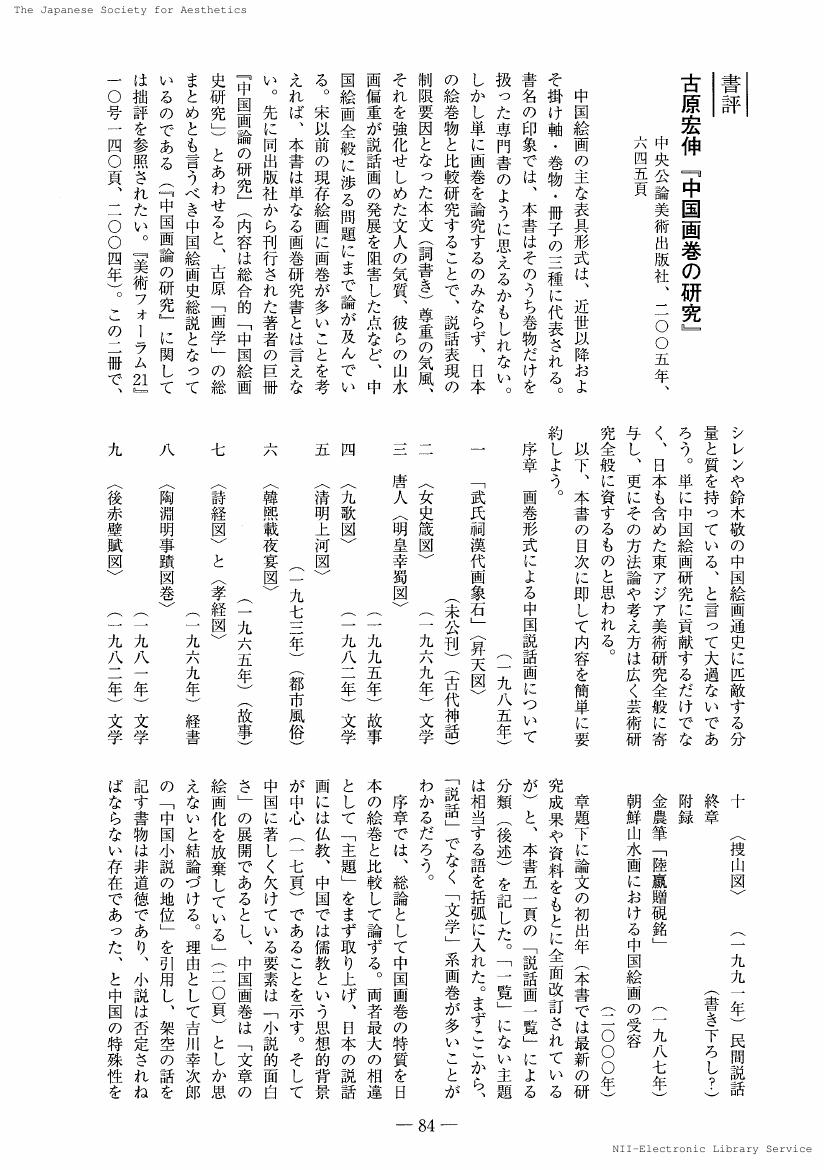- 著者
- 長田 謙一
- 出版者
- 美学会
- 雑誌
- 美学 (ISSN:05200962)
- 巻号頁・発行日
- vol.57, no.2, pp.29-42, 2006-09-30 (Released:2017-05-22)
In recent years, researches concerning the representative work of Koga Harue's Surrealism, Umi (1929), have pinpointed the sources to the various images portrayed therein. But, they have only deepened its enigmatic character. This paper, however, sheds new light on Koga's art. Constituted in combination with an analogue of a girl in swimsuit (right), the industrial machine imagery (top left) holds an important significance decisive to the understanding of the work's composition and meaning. The source to this image is found in the blast furnace photograph published in the German popular science journal, "Wissen und Fortschritt" (1927-10). Yanase Masamu's CAPITALISMUS too is understood to have been based on the same blast furnace Herrenwyk (Lubeck) photograph, anticipating an affinity between Koga and Yanase. Further, the introductory poem by Koga reveals how a "revolving of the world" image, akin to that of proletariat art, cuts across Umi. But, what is more important with regards Koga's "revolving" image is the collage hier ist noch alles in der schwebe (1920) by Max Ernst. "Soluble Fish" (^military vessel pouring out smoke and whose bowels are transparent=smoke-bellowing ship), with moorings in Ernst, becomes a symbol of the principle in Koga's surrealistic painting and appears frequently in a number of works post-Umi. On the bottom left of his second representative work, Sougai no Keshou (1930), there is an allusion made to a photograph of the metalwork studio of Bauhaus. From a "Romanticism of the machine" of the Umi to a "Realism of the machine" (Itagaki Takaho), as evident in the allusion to Bauhaus, Sougai no Keshou shows how Koga's "Mechanism" underwent a huge gyratory motion.
1 0 0 0 OA ブルレにおける新音楽の時間的統一性 : 沈黙と瞬間を媒介として
- 著者
- 佐藤 真紀
- 出版者
- 美学会
- 雑誌
- 美学 (ISSN:05200962)
- 巻号頁・発行日
- vol.57, no.2, pp.57-69, 2006-09-30 (Released:2017-05-22)
La musique nouvelle acheve de s'affranchir des ordres tonals, et la se revele l'abondance de la matiere sonore. Mais la suffisance du son, elle fait la musique discontinue. La discontinuite pourrait etre met en danger de reduire l'oeuvre musicale a neant. Alors, Brelet trouve l'unite du temps dans la musique nouvelle pour vaincre la negation de soi. C'est le silence et l'instant de donner le moment de l'unite du temps. Le silence n'est jamais le neant, mais une source originelle ou sommeillent toutes les virtualites sonores, et fait ressortir l'instant sonore, centre sur lui-meme, dans son autonomie et sa suffisance. La suffisance de l'instant libere l'auditeur du souvenir et de l'attente pour le concentre sur "le maintenant" de l'instant. Et chaque instant s'est renouvelle perpetuellement par l'imprevisibilite du temps reel. De la, on trouve l'unite du temps vivant. Ce n'est rien d'autre que le temps musical chez Brelet.
1 0 0 0 OA 舞台装置家シンケルと世界の「舞台」化 : 《魔笛》背景案による空間演出を中心に
- 著者
- 長野 順子
- 出版者
- 美学会
- 雑誌
- 美学 (ISSN:05200962)
- 巻号頁・発行日
- vol.57, no.2, pp.70-83, 2006-09-30 (Released:2017-05-22)
Karl Friedrich Schinkel, the pre-eminent architect of 19th-century Prussia, also worked in other areas, for example, landscape painting, diorama (then fashionable) and city planning (Berlin) . Returning from the Grand Tour, Schinkel began to work with the Gropius company, scenic designers, on panoramas and dioramas. Using new optical techniques, he tried to recapture his sublimely dislocating experience in the Italian landscape, that had altered his very sense of his own body. He thought he could apply these techniques directly to theatrical set design, which, through pictorial near-illusion, would transport the spectators into the imaginary quasi-reality of the drama. Schinkel's outstanding stage designs for The Magic Flute are the pinnacle of his accomplishment as a scenographer. As superintendent of the Berlin city planning department, he extended his theatrical conceptions to the wider spheres of architecture and urban design. In conceiving the Berlin cityscape as a stage setting, he was a precursor of the politics of spectacle.
- 著者
- 柿沼 美穂
- 出版者
- 美学会
- 雑誌
- 美学 (ISSN:05200962)
- 巻号頁・発行日
- vol.57, no.2, pp.87, 2006-09-30 (Released:2017-05-22)
- 著者
- 渋谷 拓
- 出版者
- 美学会
- 雑誌
- 美学 (ISSN:05200962)
- 巻号頁・発行日
- vol.57, no.2, pp.89, 2006-09-30 (Released:2017-05-22)
- 著者
- 高木 友絵
- 出版者
- 美学会
- 雑誌
- 美学 (ISSN:05200962)
- 巻号頁・発行日
- vol.57, no.2, pp.90, 2006-09-30 (Released:2017-05-22)
1 0 0 0 OA 近世初期京の絵師と唐物屋(西部会第二五八回研究発表会,例会・研究発表会要旨)
- 著者
- 山本 真紗子
- 出版者
- 美学会
- 雑誌
- 美学 (ISSN:05200962)
- 巻号頁・発行日
- vol.57, no.2, pp.91, 2006-09-30 (Released:2017-05-22)
1 0 0 0 OA 創造性の伝播 : ベルクソン美学への一視座
- 著者
- 村上 龍
- 出版者
- 美学会
- 雑誌
- 美学 (ISSN:05200962)
- 巻号頁・発行日
- vol.57, no.1, pp.28-41, 2006-06-30 (Released:2017-05-22)
Apres L'evolution creatrice (1907), H. Bergson (1859-1941) semble fortement s'interesser a l'art. Je cherche a eclaircir cet interet. Bergson, ayant trouve, dans L'evolution, l'≪elan de vie≫, c'est-a-dire, la poussee interne de l'evolution vitale, se trouve en face du probleme de Dieu, considere comme son origine. Il veut affronter ce probleme en fixant ses yeux sur les innovateurs moraux, precisement ou, mentionnant la parente avec la morale, il avoue son interet pour l'art Done, on peut supposer que cet interet etait oriente vers les innovateurs moraux. En effet, dans Les deux sources de la morale et de la religion (1932), tandis qu'il traite la transmission de l'≪elan de vie≫ de Dieu a l'humanite par l'intermediaire des mystiques ou des innovateurs moraux superieurs, Bergson fait aussi mention de la transmission de l'≪elan de l'artiste≫ par l'intermediaire de l'oeuvre geniale. Or, avant Les deux sources, Bergson, dans Le rire (1900), avait suggere le rapport de la transmission par l'intermediaire de l'ceuvre geniale. De la, l'hypothese que Bergson, apres L'evolution, medite sur les innovateurs moraux ou mystiques, se referant a son idee d'oeuvre geniale.
1 0 0 0 OA パウル・クレーの<都市画>について : 造形色彩論の観点から
- 著者
- 松友 知香子
- 出版者
- 美学会
- 雑誌
- 美学 (ISSN:05200962)
- 巻号頁・発行日
- vol.57, no.1, pp.42-55, 2006-06-30 (Released:2017-05-22)
Unter den ca. 9.000 Werken von Paul Klee gibt es ca. 180 Bilder, in denen die "Stadt" thematisiert wird. Diese Werke konnen die "Stadt-Bilder" genannt werden. In der bish-erigen Forschungsgeschichte wurde aber auf diese Bildergruppe nicht achtgegeben. Es wurde auch nicht uberlegt, welchen Sinn diese Bilder haben. Bei der naheren Betrachtung ergibt sich, dass diese Stadt-Bilder in drei verschiedenen Epochen hergestellt wurden, und der Charakter der Bilder in diesen Epochen von einander differenziert wird. In der vorliegenden Arbeit wird zunachst versucht, einen Uberblick liber diese Stadt Bilder zu werfen. Dann werden die Bilder in der dritten Epoche eigens in Betracht gezogen, da der von Klee verstandene Sinn der "Stadt" mit der Entwicklung seiner Welt- und Naturanschauung erst in dieser Epoche in der reifen Form zum ktinstlerischen Ausdruck gebracht wird. Um diese Interpretation mit dem konkreten Beispiel zu belegen, wird das representative Werk Klees, "Ein Blatt aus dem Stadtebuch", aufgenommen und ausfuhrlich analysiert. Es wird am Ende klar, dass Klee die in der modernen Stadt verborgene Spannung zwischen der Erde als dem Diesseits und dem Himmel als dem Jenseits mit der symbolischen Figur einer "Scheibe" und durch eine gewisse Farbenkombination als Folge seiner "Farbenlehre" darstellt.
1 0 0 0 OA 狩野永納筆<十二ヶ月歌意図屏風>について : 画域の拡大による新規需要への対応
- 著者
- 多田羅 多起子
- 出版者
- 美学会
- 雑誌
- 美学 (ISSN:05200962)
- 巻号頁・発行日
- vol.57, no.1, pp.56-69, 2006-06-30 (Released:2017-05-22)
"Folding Screen Painting to Explain Meaning of Twelve-Month Songs" by Kano Einou (1631-97) is a pair of six-panel screen paintings on the basis of the waka poem of "Hatakeyamasyousakutei-siika". Uta-e (the painting basis on the waka poem) revived at the beginning of the early Kinsei era accompanying the revival of the court world of waka poetry, and "Hatakeyamasyousakutei-siika" also revived as a theme of a painting at that time. The work by Kano Einou is a very early example at this time. The purpose of this paper is to clarify the details, background, and his aim that Einou who was not specialist of yamato-e drew the painting on the basis of the waka poem eagerly, and to show how to have made up his own style in his producing such a work. In conclusion, Einou can be considered as one of a pioneer in the field of folding screen painting with waka poem by the painter who was not specialist of yyamato-e. He used the network succeeded from the grandfather Kano Sanraku and father Kano Sansetsu, and learned the technique of yamato-e, and worked on new theme actively. It can be said that work that he increased possessed important significance in followers such as Kano Eikei and Ogata Kourin.
- 著者
- 植田 彩芳子
- 出版者
- 美学会
- 雑誌
- 美学 (ISSN:05200962)
- 巻号頁・発行日
- vol.57, no.1, pp.70-83, 2006-06-30 (Released:2017-05-22)
In 1898, Okakura Kakuzo chose "Expression" as an objective at the first Nippon Bijutsuin Exhibition in Tokyo. After the autumn of 1897, the "Expression" became a terminology to critique exhibitions, but not before spring 1897. What did "Expression" mean? Why did the critics of the time pay attention to it? How did a modern Japanese painting artist, Yokoyama Taikan, apply this concept in his art? Yokoyama Taikan's Listening to the Buddha's Laws was considered as the work that followed the concept of "Expression." Taikan himself revealed that he explored the concept in his work. We understand from his explanation that "expression" for Taikan meant the expressions of people's emotion. My research found the two sources to be the cause of such a new trend: one was Suematsu Kencho's article, "Query on Japanese Painting," published on July 19, 1897 in the Yomiuri Newspaper, and the other was Lafcadio Hearn's "Theory of Japanese Painting," in Taiyo, vol. 3, #5, published on July 20, 1897. These articles caused the debate on "Expression." Taikan tried the technique of chiaroscuro for the first time in Listening to the Buddha's Laws to experiment the concept of "Expression," because the debate was focused on the relationship between the expression and the techniques of chiaroscuro.
1 0 0 0 OA 古原宏伸, 『中国画巻の研究』, 中央公論美術出版社, 二〇〇五年, 六四五頁
- 著者
- 河野 道房
- 出版者
- 美学会
- 雑誌
- 美学 (ISSN:05200962)
- 巻号頁・発行日
- vol.57, no.1, pp.84-86, 2006-06-30 (Released:2017-05-22)
1 0 0 0 OA W・J・T・ミッチェルにおけるイメージの機能
- 著者
- 平塚 弘明
- 出版者
- 美学会
- 雑誌
- 美学 (ISSN:05200962)
- 巻号頁・発行日
- vol.57, no.2, pp.1-14, 2006-09-30 (Released:2017-05-22)
Visual Culture Studies, which attaches importance to the sociality or historicality of vision, has revealed the problem of power which underlies "seeing", but on the other hand runs the danger of reducing "seeing" to a mere repetition of social structure or discourse. This paper aims to discover within "seeing" itself a way to break through the constructed nature of it by considering the notion of the Image and its double function in the theory of W. J. T. Mitchell. Mitchell defines the Image as a "natural sign", a sign which represents a resemblance in a given representation system. One of its social functions is to provide in a natural form the basis for "seeing" to those who share the same representation system. This basis is formed and functions not by the power of the Image itself, but through our narrations concerning the Image. However, the Image, as a natural sign, has a further function of making visible the basis itself for "seeing". Such a recognition of the Image is not "seeing" on a particular basis but is itself the basis for "seeing", and thus differs from seeing within "a prescribed set of possibilities". In narrating concerning the Image, we forget what lies outside of the possibilities even though we experience it continually.
1 0 0 0 OA ワーグナー『ニーベルングの指環』における森の小鳥について
- 著者
- 小宮山 晶子
- 出版者
- 美学会
- 雑誌
- 美学 (ISSN:05200962)
- 巻号頁・発行日
- vol.56, no.4, pp.69-82, 2006-03-31 (Released:2017-05-22)
In der vorliegenden Arbeit ist der Versuch unternommen worden, die Funktion des Waldvogels im zweiten Akt von Siegfried zu erhellen, um dadurch einen neuen Aspekt auf das Drama zu werfen. Uber diesen Vogel wurde in der Forschung selten diskutiert. Dort gait er als "Naturwesen" oder "Reinkarnation von Siegfrieds Mutter"; die letztgenannte Interpretation etablierte sich aufgrund der angeblichen AuJSerung Wagners, der Waldvogel sei die mutterliche Seele Sieglindes. Es ist jedoch schwer vorstellbar, dass Sieglinde ihrem Sohn empfohlen haben soil, den unheilbringenden Ring sowie den Tarnhelm an sich zu nehmen. Bei einer genauen Quellenpriifung wurde nachgewiesen, dass Wagners diesbeziigliche Worte in Wirklichkeit nicht existieren. Dariiber hinaus wurde versucht, das Wesen des Vogels nicht nur von seiten des Dramentextes, sondern auch von der Leitmotivik her zu beleuchten. Daraus ergab sich, dass der Vogel wohl eine Inkarnation Loges ist. Die Verwandlung Loges(Lokis) als Vogel laBt sich in den germanischen Sagen haufig nachweisen, so etwa in Edda. Nachdem Loge am Schluss Des Rheingoldes Rache geschworen hatte, verschwand er, um dann entweder nur leitmotivisch oder als Waldvogel auf sich aufmerksam zu machen. Loge bewog Siegfried dazu, den Ring zu ubernehmen, damit die Vernichtung der Gotter und die Ruckgabe des Goldes an den Rhein vollbracht werden konnen.
1 0 0 0 OA ヘルダーの共通感覚論 : 共感覚概念の誕生
- 著者
- 杉山 卓史
- 出版者
- 美学会
- 雑誌
- 美学 (ISSN:05200962)
- 巻号頁・発行日
- vol.57, no.1, pp.1-14, 2006-06-30 (Released:2017-05-22)
This paper reflects on Herder's concept of "common sense", understood in terms of sense common to all the senses. His saying "we are a thinking sensorium commune" from his Treatise on the Origin of Language (1772) has received increasing attention in recent years as it is thought to be at the origin of the concept of synesthesia. But why so? According to contemporary medical-psychological research, synesthesia is the concrete experience of fusion of the senses located in the limbic system. This means that synesthesia is the opposite of the Aristotelian conception of common sense, because the latter is the faculty to grasp abstract qualities. Herder's "sensorium commune" has a different connotation. By using this expression he meant that all the senses are originally one and the same (=feeling); they become differentiated from this and work together. This level is prior to both the birth of language and the judgment of beauty. Herder is the one who formulated such a conception of common sense, (which is not the faculty to grasp abstract qualities), for the first time in the history of ideas. This is why his "sensorium commune" is at the origin of the idea of synesthesia.
1 0 0 0 OA フリードリヒ・シュレーゲルと「断片」の精神 : ロマン主義の美学への一つの断章
- 著者
- 小田部 胤久
- 出版者
- 美学会
- 雑誌
- 美学 (ISSN:05200962)
- 巻号頁・発行日
- vol.57, no.1, pp.15-27, 2006-06-30 (Released:2017-05-22)
Die sich ihrer Modernitat bewussten Fruhromantiker, vor allem Fr. Schlegel, haben Fragmente mit Absicht verwendet, wie es sich aus einem Fragment von Fr. Schlegel ergibt: "Viele Werke der Alten sind Fragmente geworden. Viele Werke der Neuern sind es gleich bei der Entstehung." Im vorliegenden Aufsatz versucht der Verfasser nicht, das Fragment als eine literarische Gattung zu behandeln, sondern es geht darum, zu zeigen, dass der Geist des Fragments dem Gedanken Schlegels zugrunde liegt. Im Studium-Aufsatz von 1795 stellt Schlegel die vollendete Schonheit der alten Kunstwerke dem Fragmentarischen der modemen Kunstwerke gegeniiber. Ab 1797 leugnet er einen solchen Dualismus. Schlegels neue Auffassung des Fragments lasst sich in seiner Behauptung erkennen, dass das "Reifste und Vollendetste" "Bruchstucke von Bruchstucken" seien. Fragmente konnen "vollendet" sein, sofern sie "Winke und Andeutungen" sind. In diesem Sinne sind Fragmente Projekten gleichgesetzt. Und Fragmente als Winke und Andeutungen mussen mit der sie erganzenden bzw. verwirklichenden "Kritik", die selbst nicht anders als fragmentarisch sein kann, verbunden werden. Aufgrund einer solchen Erganzung vermitteln die Fragmente das Einzelne mit dem Ganzen, das Endliche mit dem Unendlichen, die Wirklichkeit mit der Moglichkeit und die Gegenwart mit der Zukunft.
- 著者
- 吉田 寛
- 出版者
- 美学会
- 雑誌
- 美学 (ISSN:05200962)
- 巻号頁・発行日
- vol.56, no.3, pp.89, 2005-12-31 (Released:2017-05-22)
- 著者
- 村瀬 博春
- 出版者
- 美学会
- 雑誌
- 美学 (ISSN:05200962)
- 巻号頁・発行日
- vol.56, no.3, pp.94-96, 2005-12-31 (Released:2017-05-22)
1 0 0 0 OA 近代絵画における語りの視点
- 著者
- 西村 清和
- 出版者
- 美学会
- 雑誌
- 美学 (ISSN:05200962)
- 巻号頁・発行日
- vol.56, no.4, pp.1-14, 2006-03-31 (Released:2017-05-22)
As opposed to the linear perspective since Renaissance, Wolfgang Kemp recognizes new ways of pictorial composition in the 19th century which constitute new types of spectators seeing the world from their particular positions. Then he argues a parallelism between the new perspectives of modern paintings and those of modern novels. Different from the transcendent and omniscient viewpoint of narrating stories in the old age, and from the omniscient and transcendental viewpoint based on linear perspective, modern historical paintings and novels were concerned with narrative modes of individual experiences. According to Kemp, paintings newly defined spectators as individual witnesses of depicted events. But he does not assign the narrative mode of 'la vision ≪avec≫' (Jean Pouillon) to paintings which lets readers stand at the position of a diegetic character, because paintings always require the physical presence of spectators standing in front of them. He confuses the 'angle' of physical eye with the 'viewpoint' of narration. In fact, the narrative mode of 'la vision ≪avec≫' exists in paintings as well.
1 0 0 0 OA ニーチェにおける<芸術家の誠実さ>について
- 著者
- 山本 恵子
- 出版者
- 美学会
- 雑誌
- 美学 (ISSN:05200962)
- 巻号頁・発行日
- vol.56, no.4, pp.27-40, 2006-03-31 (Released:2017-05-22)
This article considers Nietzsche's concept of the artist in terms of Redlichkeit (sincerity; uprightness) in the late Nietzsche. In his discussion regarding art and the artist, he suggests the artist is most great among human beings, and art is contrary to Christian morality. Furthermore, he argues that the artist must be redlich. However, why is Nietzsche affirmative on the Christian virtue of Redlichkeit, but negative on Christian morality? It is through the break of existent moral values that the sincere Self can create value autonomously, i.e. Redlichkeit is not to others but to the Self for Nietzsche. Beyond that, the creating Self even breaks the value created by itself. That is to say, Redlichkeit to the Self is Redlichkeit against the Self also. I consider this Redlichkeit a fundamental requirement for creation, and I explain concretely what Nietzsche meant by the creation of art, when the artist is redlich through reference to Richard Wagner.






